Top 5 Usability Features in Locus EIM
Locus EIM is the leading cloud-based application for managing and reporting environmental data. We have highlighted 5 key usability features that allow users to get the most out of their investment.
Locus EIM is the leading cloud-based application for managing and reporting environmental data. We have highlighted 5 key usability features that allow users to get the most out of their investment.
The recent year of lockdowns pushed many daily activities into the virtual world. Work, school, commerce, the arts, and even medicine have moved online and into the cloud. As a result, considerably more resources and information are now available from an internet browser or from an application on a handheld device. To navigate through all this content and make sense of it, you need the ability to quickly search and get results that are most relevant to your needs.
You can think of the web as a big database in the cloud. Traditionally, database searches were done using a precise syntax with a standard set of keywords and rules, and it can be hard for non-specialists to perform such searches without learning programming languages. Instead, you want to search in as natural a matter as possible. For example, if you want to find pizza shops with 15 miles of your house that offer delivery, you don’t want to write some fancy statement like “return pizza_shop_name where (distance to pizza shop from my house < 15 miles) and (offers_delivery is true). You just want to type “what pizza shops within 15 miles of my house offer delivery?” How can this be done?
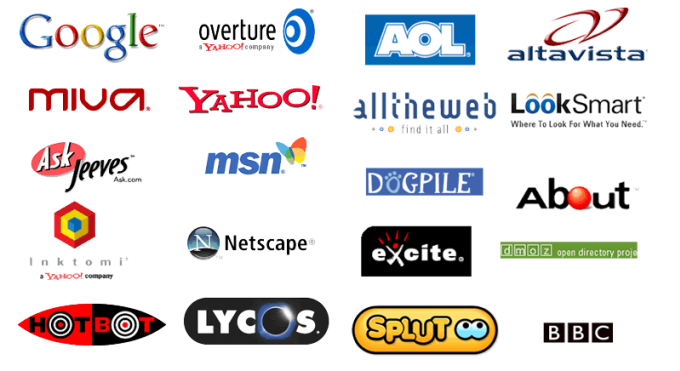
Enter the search engine. While online search engines appeared as early as 1990, it wasn’t until Yahoo! Search appeared in 1995 that their usage became widespread. Other engines such as Magellan, Lycos, Infoseek, Ask Jeeves, and Excite soon followed, though not all of them survived. In 1998, Google hit the internet, and it is now the most dominant engine in use. Other popular engines today are Bing, Baidu, and DuckDuckGo.
Current search engines compare your search terms to proprietary indexes of web page and their content. Algorithms are used to determine the most relevant parts of the search terms and how the results are ranked on the page. Your search success depends on what search terms you enter (and what terms you don’t enter). For example, it is better to search on ‘pizza nearby delivery’ than ‘what pizza shops that deliver are near my house’, as the first search uses less terms and thus more effectively narrows the results.
Search engines also support the use of symbols (such as hyphens, colons, quote marks) and commands (such as ‘related’, ‘site’, or ‘link’) that support advanced searches for finding exact word matches, excluding certain results, or limiting your search to certain sites. To expand on the pizza example, support you wanted to search for nearby pizza shops, but you don’t want to include Nogud Pizza Joints because they always put pineapple on your pizza. You would need to enter ‘pizza nearby delivery -nogud’. In some ways, with the need to know special syntax, searching is back where it was in the old database days!
Search engines are also a key part of ‘digital personal assistants’, or programs that not only perform searches but also perform simple tasks. An assistant on your phone might call the closest pizza shop so you can place an order, or perhaps even login to your loyalty app and place the order for you. There is a dizzying array of such assistants used within various devices and applications, and they all seem to have soothing names such as Siri, Alexa, Erica, and Bixby. Many of these assistants support voice activation, which just reinforces the need for natural searches. You don’t want to have to say “pizza nearby delivery minus nogud”! You just want to say “call the nearest pizza shop that does delivery, but don’t call Nogud Pizza”.
Search engine and digital personal assistant developers are working towards supporting such “natural” requests by implementing “natural language processing”. Using natural language processing, you can use full sentences with common words instead of having to remember keywords or symbols. It’s like having a conversation as opposed to doing programming. Natural language is more intuitive and can help users with poor search strategies to have more successful searches.
Furthermore, some engines and assistants have artificial intelligence (AI) built in to help guide the user if the search is not clear or if the results need further refinement. What if the closest pizza shop that does delivery is closed? Or what if a slightly farther pizza place is running a two-for-one special on your favorite pizza? The built-in AI could suggest choices to you based on your search parameters combined with your past pizza purchasing history, which would be available based on your phone call or credit charge history.
The Locus team recently expanded the functionality of the EIM (Environmental Information Management) search bar to support different types of data searches. If a search term fits several search types, all are returned for the user to review.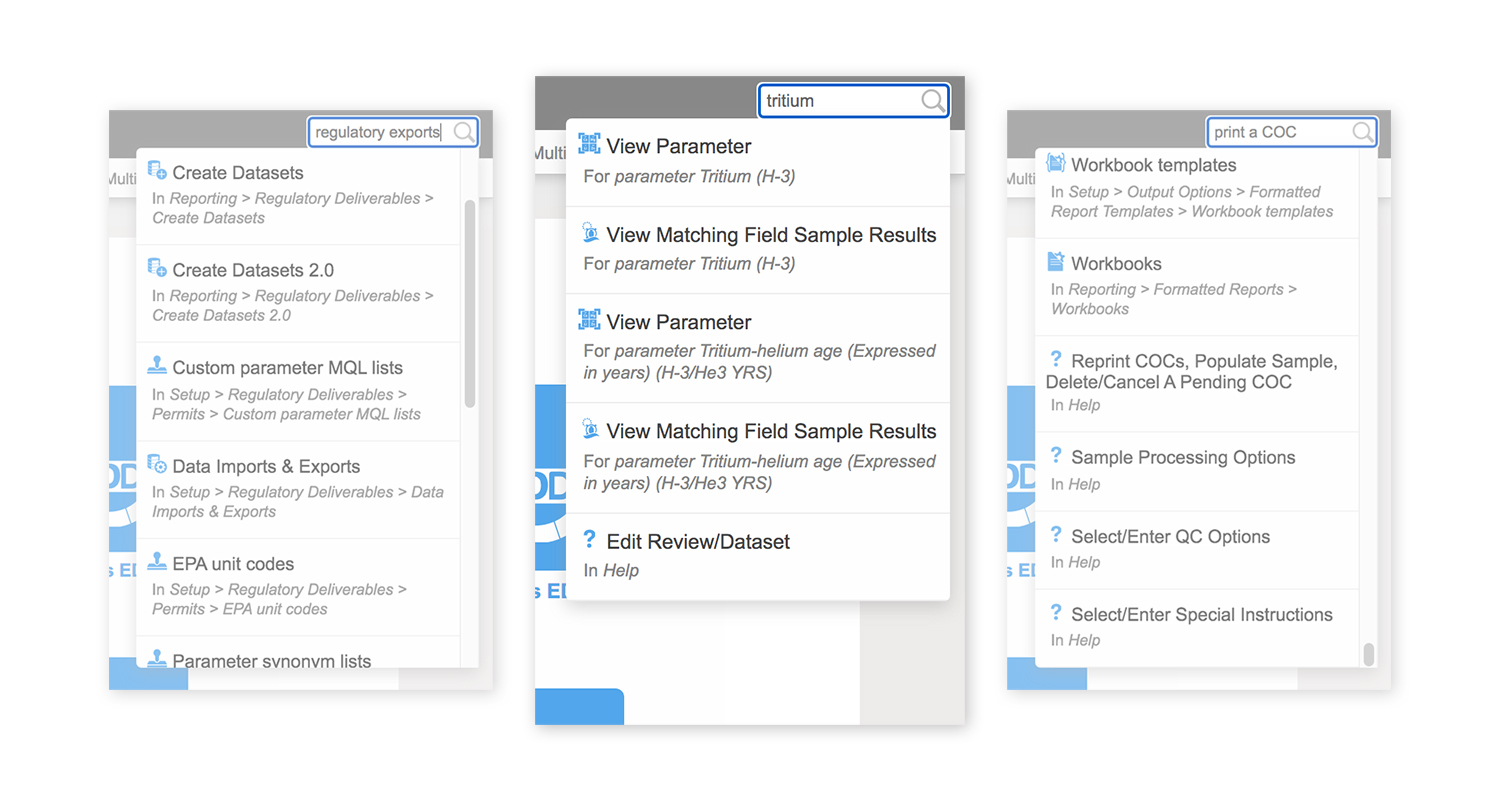
EIM lets the user perform successful searches through various methods. In all searches, the user does not need to specify if the search term is a menu item, help page, or data entity such as parameter or location. Rather, the search bar determines the most relevant results based on the data currently in EIM. Furthermore, the search bar remembers what users searched for before, and then ranks the results based on that history. If a user always goes to a page of groundwater levels when searching for location ‘MW-1’, then that page will be returned first in the list of results. Also, the EIM search bar supports common synonyms. For example, searches for ‘plot’, ‘chart’, and ‘graph’ all return results for EIM’s charting package.
By implementing the assistance methods described above, Locus is working to make searching as easy as possible. As part of that effort, Locus is working to add natural language processing into EIM searches. The goal is to let users conduct searches such as ‘what wells at my site have benzene exceedances’ or perform tasks such as ‘make a chart of benzene results’ without having to know special commands or query languages.’
How would this be done? Let’s set aside for now the issues of speech recognition – sadly, you won’t be talking to EIM soon! Assume your search query is ‘what is the maximum lead result for well 1A?’
A similar process could be done for tasks such as ‘make a chart of xylene results’. In this case, however, there is too much ambiguity to proceed, so EIM would need to return queries for additional clarifications to help guide the user to the desired result. Should the chart show all dates, or just a certain date range? How are non-detects handled? Which locations should be shown on the chart? What if the database stores separate results for o-Xylene, m,p-Xylene, plus Xylene (total)? Once all questions were answered, EIM could generate a chart and return it to the user.
Natural language is the key to helping users construct effective searches for data, whether in EIM, on a phone, or in the internet. Locus continues to improve EIM by bringing natural language processing to the EIM search engine.
About the Author—Dr. Todd Pierce, Locus Technologies
Dr. Pierce manages a team of programmers tasked with development and implementation of Locus’ EIM application, which lets users manage their environmental data in the cloud using Software-as-a-Service technology. Dr. Pierce is also directly responsible for research and development of Locus’ GIS (geographic information systems) and visualization tools for mapping analytical and subsurface data. Dr. Pierce earned his GIS Professional (GISP) certification in 2010.
Simplify your air quality data management and reporting with Locus’ unified software solution. Our Air Quality application resolves most common issues with managing and submitting your site emissions data. Locus handles all required regulatory data from your facilities in one centralized platform and makes it possible to streamline your tracking and reporting requirements for programs such as Title V, GHG, Fenceline, and LCFS.
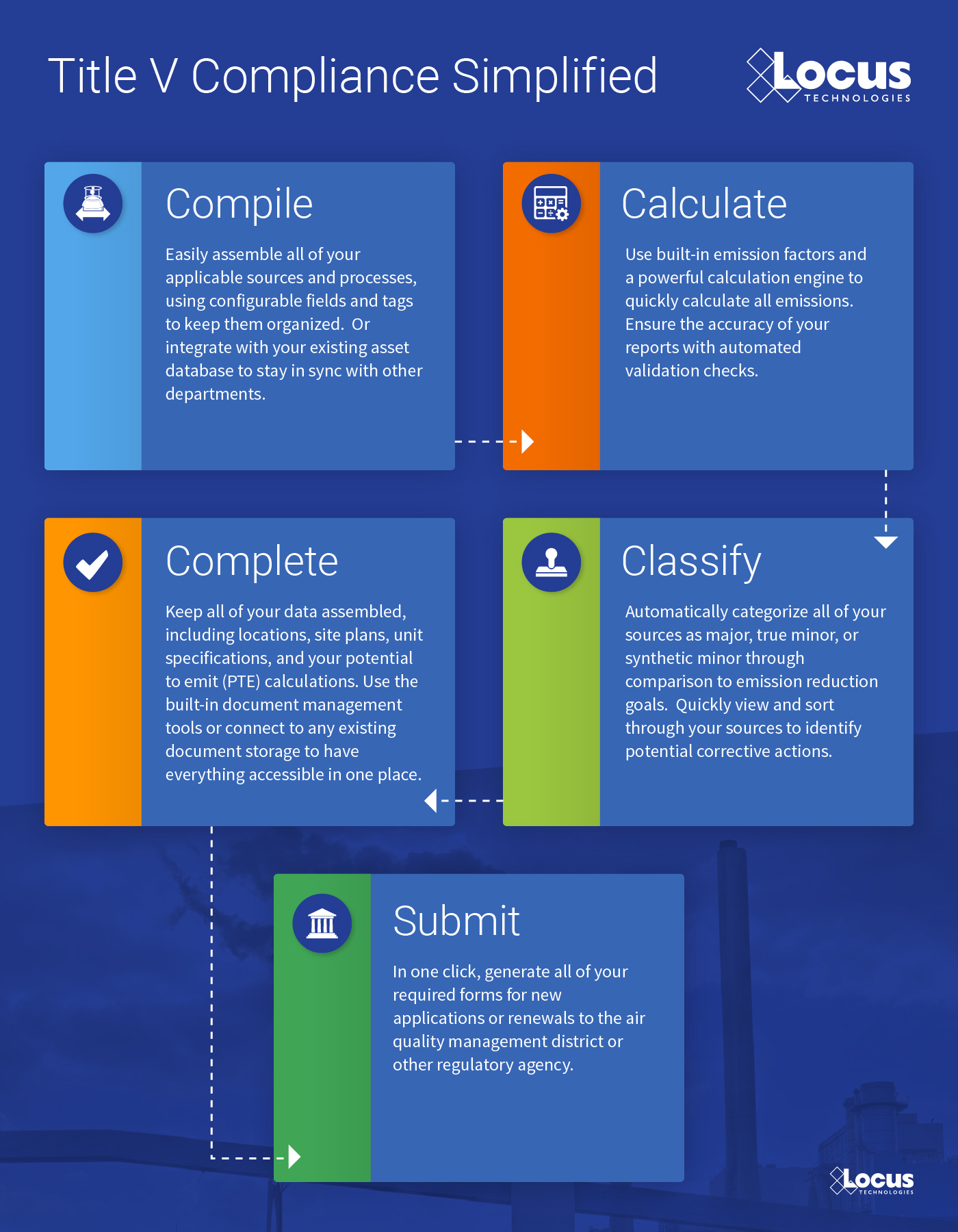
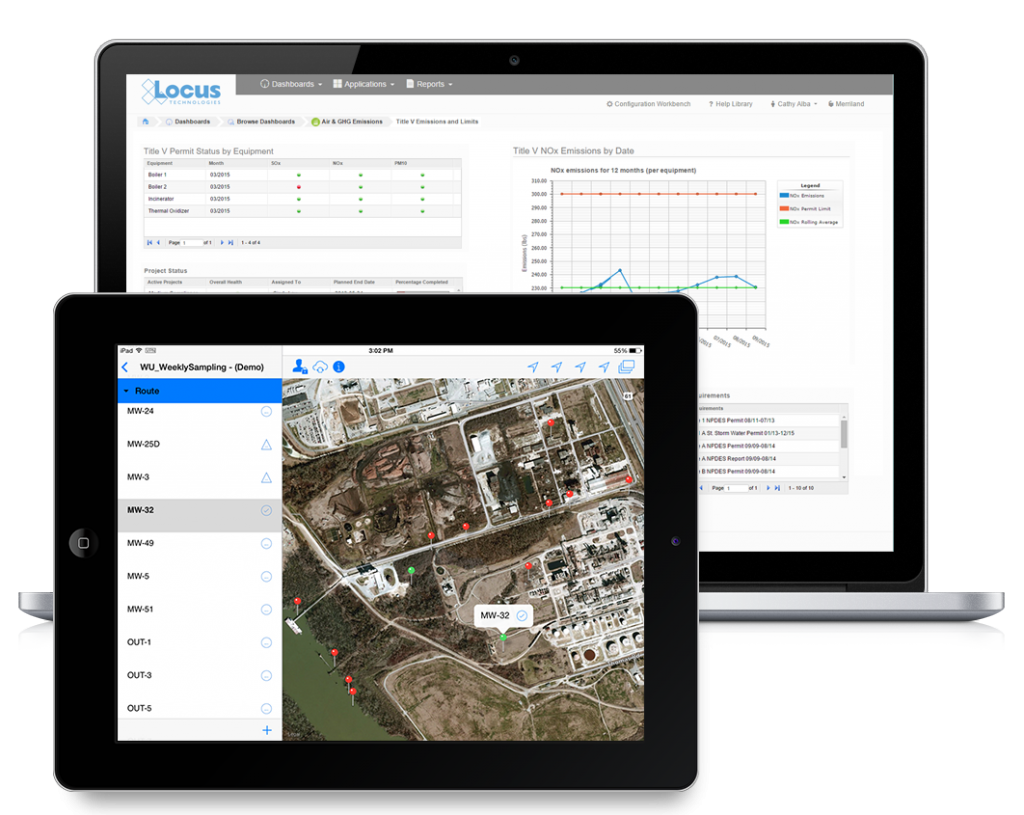
Maybe you are a user of Locus’ Environmental Software (EIM) and are looking to get more out of our product. Or perhaps you are using another company’s software platform and looking to make a switch to Locus’ award-winning solution. Either way, there are some features that you may not know exist, as Locus software is always evolving by adding more functionality for a range of customer needs. Here are five features of our environmental software that you may not know about:
Locus expanded the EIM application programming interface (API) to support running any EIM Expert Query. Using a drag and drop interface, an EIM user can create an Expert Query to construct a custom SQL query that returns data from any EIM data table. The user can then call the Expert Query through the API from a web browser or any application that can consume a REST API. The API returns the results in JSON format for download or use in another program. EIM power users will find the expanded API extremely useful for generating custom data reports and for bringing EIM data into other applications.
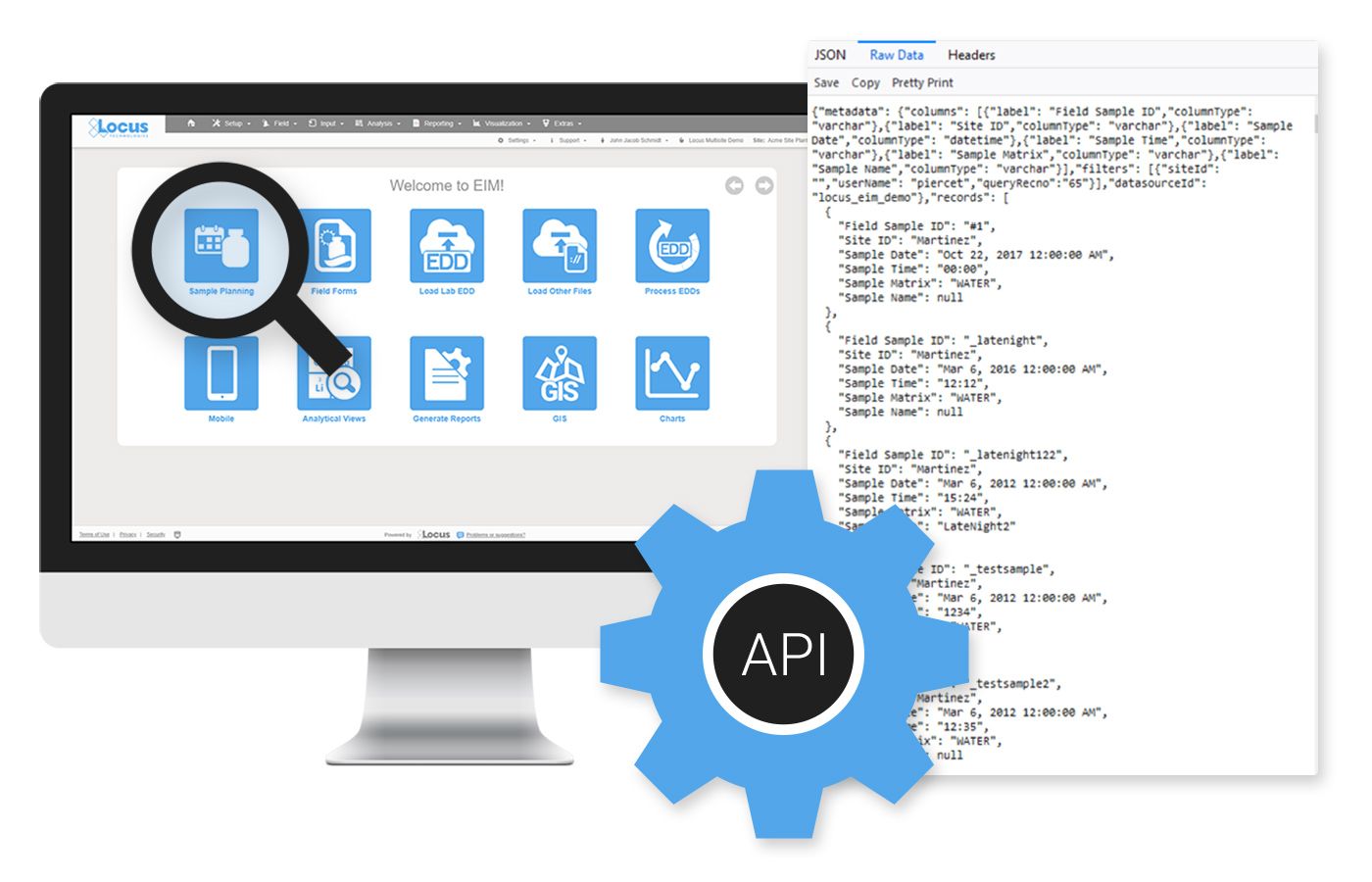
The Expert Query Builder lets users schedule their custom queries to run at given times with output provided in an FTP folder or email attachment. Users can view generated files through the scheduler in a log grid, and configure notifications when queries are complete. Users can scheduled queries to run on a daily, weekly, monthly, or yearly basis, or to run after an electronic data deliverable (EDD) of a specified format is loaded to EIM. Best of all, these queries can be instantly ran and configured from the dashboard.
Multiple charts can be created in EIM at one time. Charts can then be formatted using the Format tab. Formatting can include the ability to add milestone lines and shaded date ranges for specific dates on the x axis. The user can also change font, legend location, line colors, marker sizes and types, date formats, legend text, axis labels, grid line intervals or background colors. In addition, users can choose to display lab qualifiers next to non-detects, show non-detects as white filled points, show results next to data points, add footnotes, change the y-axis to log scale, and more. All of the format options can be saved as a chart style set and applied to sets of charts when they are created.
To help customers find the correct EIM menu function, Locus added a search box at the top right of EIM. The search box returns any menu items that match the user’s entered search term.
When the user runs the template for a specific set of locations, EIM displays the callouts in Locus’ premium GIS software, GIS+, as a set of draggable boxes. The user can finalize the callouts in the GIS+ print view and then send the resulting map to a printer or export the map to a PDF file.
The DMR tool in Locus’ Environmental Information Management (EIM) software solves the problem of time-consuming, labor-intensive, and expensive manual report generation by automating the data assembly, calculations, and formatting of Discharge Monitoring Reports. Depending on the type of discharge and the regulatory jurisdiction, you may be required to report information such as analytical chemistry of pollutants, flow velocity, total maximum daily load, and other parameters. For companies that report on multiple facilities, producing a DMR also becomes a major expense.
Thanks to Locus’ DMR tool, companies can generate DMRs within minutes with validated data in approved formats, with all of the calculations completed according to regulatory requirements. Companies can set up EIM for its permitted facilities and realize immediate cost and time savings during each reporting period. Locus users have saved over $2,000,000 on DMR reporting.
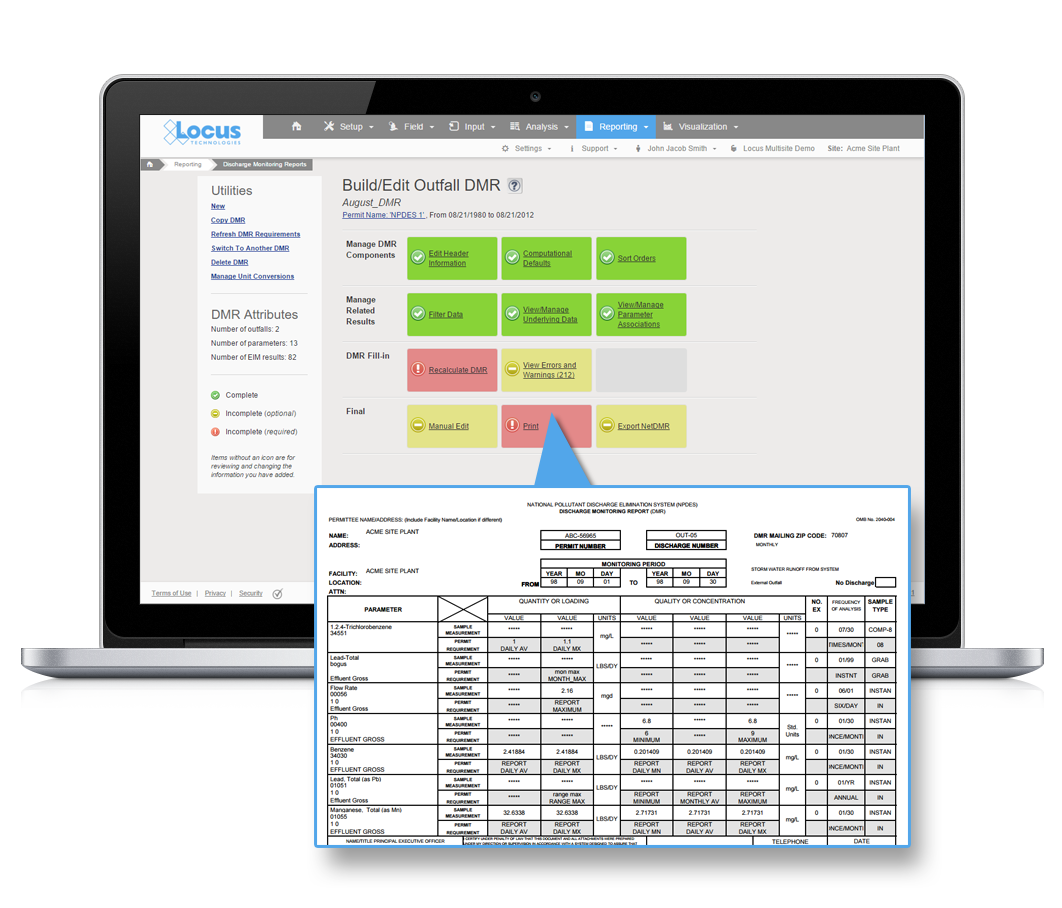
Locus continues to enhance the Discharge Monitoring Report (DMR) tool, recently implementing calculations needed to handle reporting of divalent metals. New formats, such as Florida DEP ezDMR, are regularly being added, so customers can meet their reporting requirements.
MOUNTAIN VIEW, Calif., 9 February 2021 — Locus Technologies, the leading provider of EHS Compliance and ESG software, was awarded a 15th consecutive award from Environmental Business Journal (EBJ) for growth and innovation in the field of Information Technology in the environmental industry.
EBJ is a business research publication providing strategic business intelligence to the environmental industry. Locus received the 2020 EBJ Award for Information Technology by growing and innovating their Software as a Service (SaaS) and related services.
Among the key drivers for Locus in 2020 was providing vital solutions to essential organizations during the earliest stages of the COVID-19 pandemic. Locus provided fully digital waste tracking and the tools needed for groundbreaking work in embodied carbon relating to construction projects for the Port Authority of New York and New Jersey, a potentially industry-transforming innovation.
Water utilities used Locus software to deliver over 150 billion gallons of clean water to tap, the equivalent of 235,000 Olympic-size swimming pools, for over five million consumers. Utilities also benefited from newly released Locus tools such as the direct XML export to the EPA, eliminating the need for custom reporting. Locus continued its work as a third-party verifier in Low Carbon Fuel Standard and Greenhouse Gas verifications, providing verification services for over 60 facilities totaling no less than 3.2 million barrels of crude oil, 2.6 million barrels of natural gas liquids, and 88 million bottles of wine.
“Locus continues to lead the environmental industry digital transformation with its forward-thinking product set, pure SaaS architecture and unified set of EHS Applications,” said Grant Ferrier, president of Environmental Business International Inc. (EBI), publisher of Environmental Business Journal.
“We would like to express our joy and gratitude for receiving the EBJ Information Technology award for the 15th year. We look forward to continue providing our customers with pioneering unified EHS and ESG software and services in 2021,” said Wes Hawthorne, President of Locus Technologies.
In today’s world, organizations must measure and report their environmental performance and adherence to corporate social responsibility (CSR) and environmental, social, and governance (ESG) principles. Stakeholders, including regulators, investors, customers, rating agencies, research analysts, NGOs, and the public, are all starting to evaluate non-financial criteria in addition to companies’ financial health and performance. Companies also must comply with EHS regulations in the jurisdictions in which they operate. While most environmental regulations have been around for half a century, the gathering and reporting of sustainability, CSR, and ESG data is relatively new and is becoming an essential part of corporate annual reports.
Companies are increasingly discovering that data-driven ESG reporting has gone from a “nice to have” to a business requirement. But it’s challenging to keep up with such reporting when a company’s data is in spreadsheets or numerous unconnected silo applications. Companies suffer when their domain experts and others rely on manual and outdated processes to accomplish ever-increasing reporting requirements.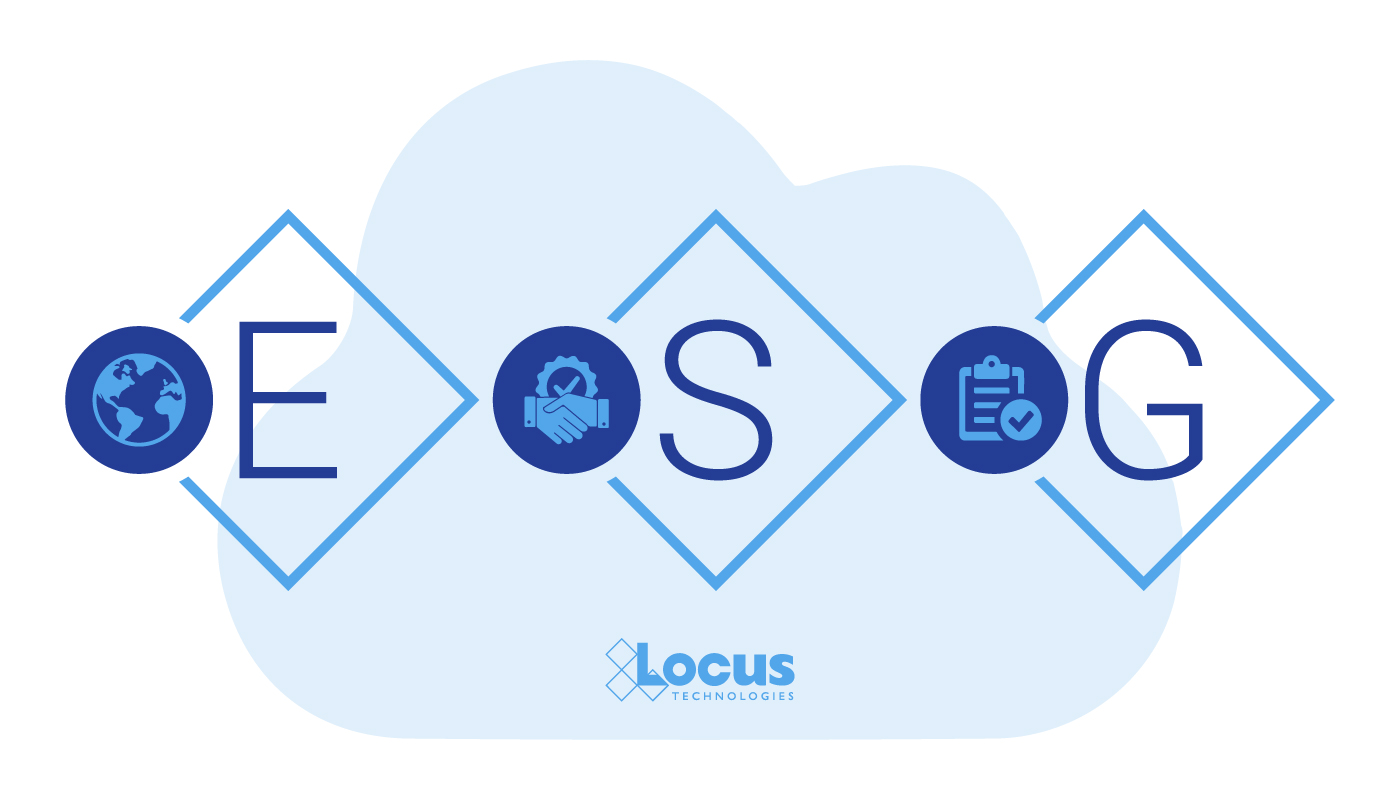
It appears imminent that the U.S. Securities and Exchange Commission (SEC) will in near future regulate ESG disclosure as a requirement by using some kind of universal reporting framework.
Wouldn’t it be nice to have a single enterprise and cloud-based software system to perform all EHS, ESG, and CSR reporting from a single software platform? That is what this article is about.
Until recently, it was common to refer to sustainability and ESG interchangeably. But over time, their meanings have grown apart. Sustainability can mean many different things, depending on the discussion context, whereas ESG has become the preferred term for capital markets and has frequently appeared in the headlines. The transition from sustainability to ESG performance indicates a maturation of business practices leading to more precise measurements of a company’s performance, its impact on the environment, and the risk it carries for investors when there is a low environmental performance or spotty compliance with EHS regulations. As a result, companies need to improve the way they collect and track metrics for ESG reporting.
To compare companies relative to their impacts on the planet’s climate or well-being, one must take a holistic approach that includes many factors. Among those to consider when assigning a score to a company are:
This holistic approach requires new, integrated, and interactive software tools. Such software, equivalent to the ERP (Enterprise Resource Planning) software that made its appearance in the early nineties, should provide complex tracking of all kinds of emissions linked to company-owned assets and services in real-time (Scope 1 emissions). It should also include emissions attributable to its supply chain, known as Scope 2 and Scope 3 emissions. Old ERP software applications integrate the processes needed to run a company in a single system: planning, purchasing inventory, sales, marketing, finance, and human resources. However, they do not typically integrate any technical information or activity related to emissions, waste, climate, environmental compliance, etc. Never mind that much of the ERP software in the market today is obsolete, running on the outdated technology of the seventies and eighties, and hard to integrate with anything.
The traditional approach of bolting-on another application to an existing software infrastructure is not the road to go down concerning ESG data collection and to report. Emissions tracking, sustainability, and other environmentally related verticals are typically “heavier” and more resource-intensive than antiquated ERP systems can handle without significant investment. Many legacy ERP systems, caving in under their weight, are hugely and unnecessarily complicated and are slowly being deprecated. New, cloud-based Software as a Service (SaaS) technologies hold more promise as they allow for the fast deployment and easy integration and sharing with third-party applications, suppliers, consultants, and even regulators. One such example is the Locus Platform or only LP. It is a SaaS that automates data collection, management, and reporting. It is of financial-grade, auditable, available, and actionable 24/7 from anywhere. This platform integrates EHS compliance and ESG reporting applications under a single system of record, giving users all necessary tools to optimize their compliance, sustainability management, and reporting.
To kill two birds with one stone! Or perhaps a friendlier version for bird-lovers is a German version, “mit einer Klappe zwei Fliegen schlagen” – which means to kill two flies with one swat. Or kill two mosquitoes with one slap! This English language idiom is not to be taken literally but instead refers to a single activity or action that accomplishes two (or more) goals or tasks. And that is precisely what any advanced EHS/ESG software should do.
Over the last twenty or so years, companies have spent considerable resources (in both time and money) buying and installing such EHS compliance-related verticals as permit management, waste, incident reporting, water quality, air emissions, greenhouse gases (GHG), sustainability, and so on.
More than one acquisition is often needed to cover their reporting needs, resulting in an assortment of tools that may or may not be compatible with one another.
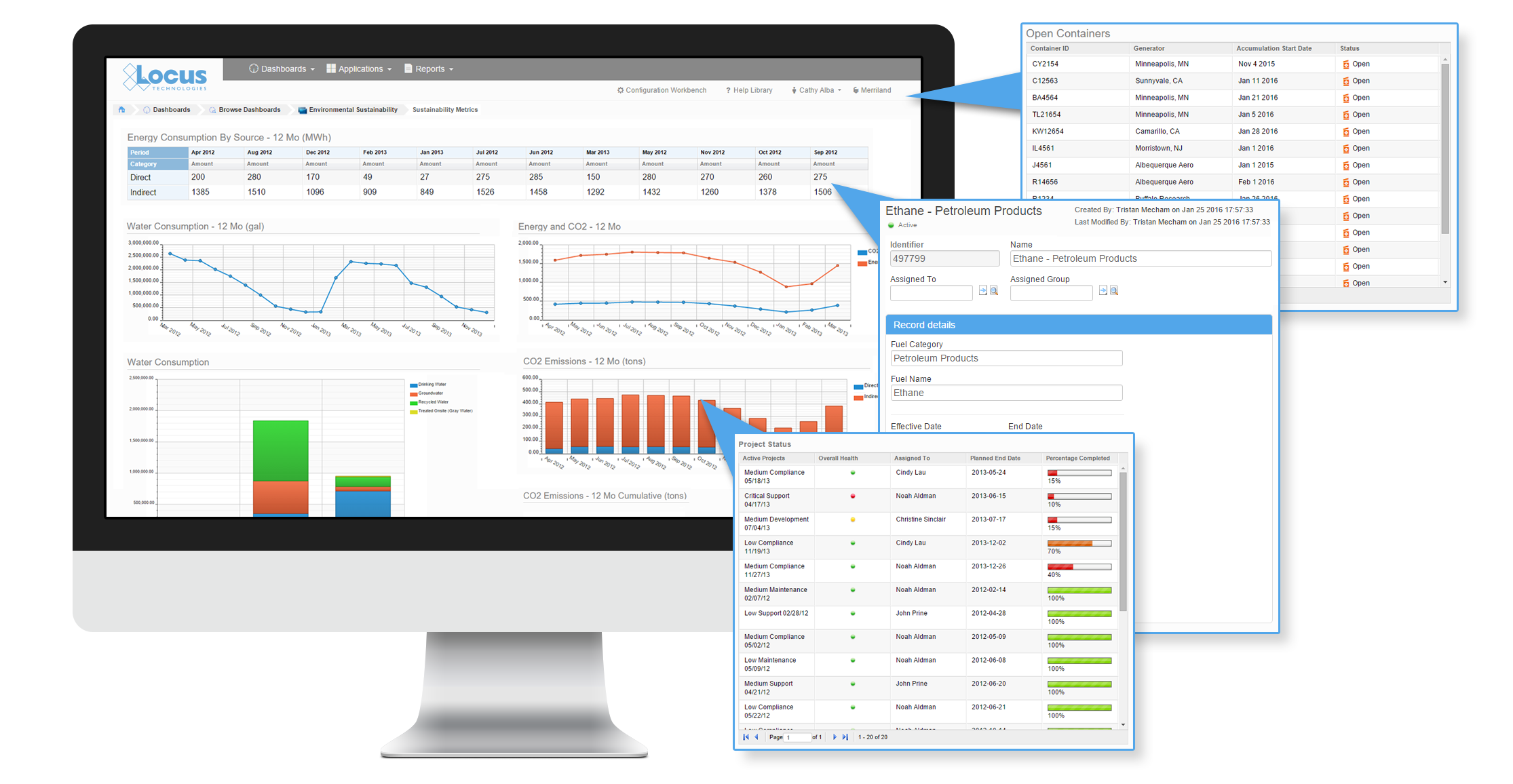
As I mentioned at the beginning of this blog, a new acronym, ESG, has recently shot to prominence. C-level executives are asking their EHS managers a question “Do we need more software to manage our ESG reporting? Smart companies should not rush and start searching Google for “ESG Software.” Instead, they should take a hard look at what they have on EHS compliance and sustainability management and augment it with ESG reporting. After all, everything that needs reporting or is worth reporting under the ESG acronym probably already exists and is hidden in their EHS compliance software, provided they selected the right one. Companies that have implemented integrated EHS compliance and sustainability management systems may already have most of the ESG data they need to report within their existing applications. If they do not, or if they have a “mutual fund” portfolio of EHS software already installed in unconnected silo applications, this is the time to clean house and switch to a unified reporting platform that integrates EHS and ESG into a single system of record and reporting. Companies that head down this path would not just be “killing two birds” but more: they would lower their costs, meet their new reporting needs, gain a better understanding of their environmental impacts, and potentially enhance their ESG reputation.
Locus specifically built its configurable Locus Platform to unify many current and future applications on a single SaaS platform. The LP offers a wide range of features and functionality to power sustainability measurement, management, and reporting across the entire corporation. But it also provides a launching pad for EHS-related and unrelated apps that are interoperable and share relevant information, thus avoiding any double input. Among its features are the following:
While EHS compliance applications are more comprehensive and dive deeper into the root causes of contamination and emissions, ESG reporting is much less complicated and requires fewer data to report and less scrutiny of such data. For example, federal and state standards such as Discharge Monitoring Reports (DMRs) require detailed water quality reporting, requiring companies to prove that their releases fall within allowable quantities (flow volume) and that chemicals in discharge samples do not exceed regulatory limits for the chemicals of concern. Consequently, the software to manage water quality for EHS reporting needs to provide automated tools to prove that: samples were collected correctly, sample holding time was not exceeded, the receiving laboratory tested samples using proper protocols, lab equipment, etc. Labs also must maintain calibration logs for equipment used in testing, testing details, and so forth.
None of these QC results and associated metadata are necessary for ESG reporting under voluntary reporting protocols such as the Carbon Disclosure Project (CDP), the Global Reporting Initiative (GRI), The Climate Registry (TCR), or GRESB, the leading ESG benchmark for real estate and infrastructure investments. Those protocols mainly require information to be assembled on volumes (quantities) of clean water used, water sources, and contaminated water discharge volumes. They may also include some identification of chemicals in releases but with no details and no testing protocols required. The GRI 303 standard on water and effluents, for example, requires companies to collect information on water use from withdrawal to consumption and discharge and to report on associated impacts on people and ecosystems, including at a local level. This standard enables investors to assess a company’s overall exposure to water risk, as it addresses the whole supply chain.
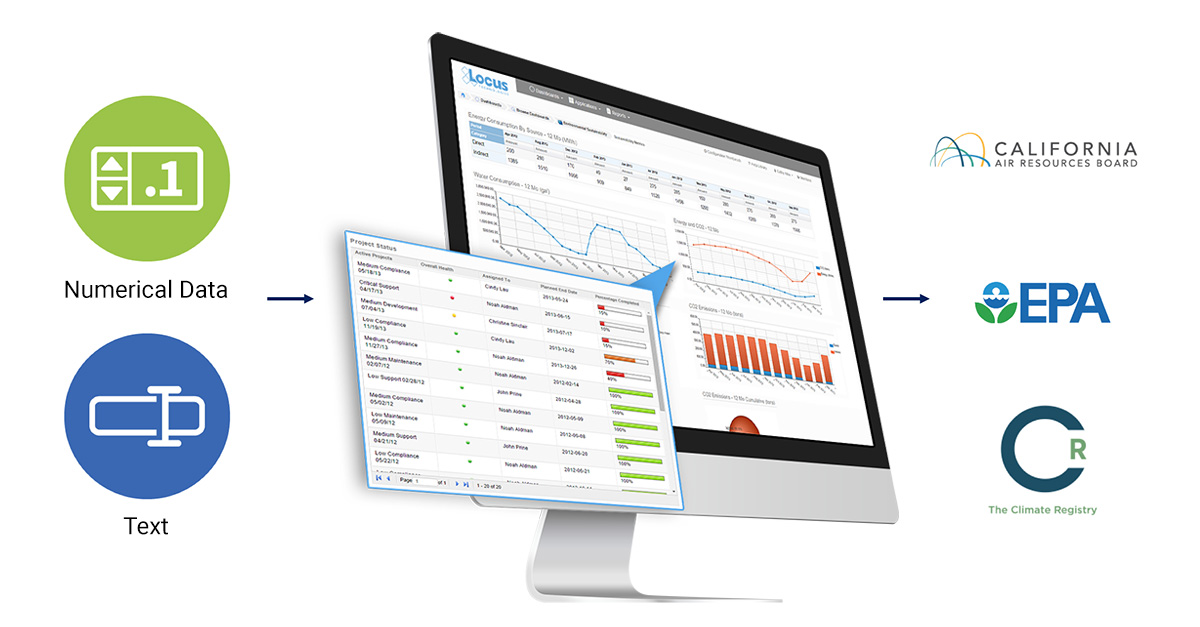
There are plenty of overlaps in this undertaking. Smart software like the Locus Platform can help avoid any double input between EHS compliance data and ESG reporting. For example, once inputted, facility information is instantly available to all apps, whether the final output of the app is for EHS or ESG reporting. If a spill incident is created and recorded in the EHS Incident App, another app for waste or groundwater contamination can track and manage that spill’s consequential emissions. Even a small spill could become costly if the spill creates long-lasting contamination of soil and groundwater below it. Reporting for spill under EHS compliance regulations is very different from reporting for ESG, yet the two can use the same database. Examples like this are numerous.
Locus continuously adds new features to its Locus Platform to expand EHS, Sustainability, and ESG interoperability and avoid and minimize data’s double input. Companies need a single system of record to house their sustainability data, EHS Compliance, and ultimately report ESG information across multiple reporting standards. Locus’ ESG SaaS delivers in this regard. Moreover, it can grow with customers’ needs thanks to its off-the-shelf configurability.
In short, the Locus Platform is an all-in-one sustainability management software tool that helps companies streamline data collection, improve data quality, benchmark performance, and communicate more effectively with internal and external stakeholders. Locus’s software automates collecting, reducing, and managing data to monitor and track critical metrics around EHS, CSR, and ESG performance. Once the data is in the Locus Platform, the software creates ESG, sustainability, and other reports adhering to multiple reporting standards to improve communications with stakeholders and show greater transparency.
Many large companies must report to various regulatory or voluntary bodies. A company’s software of choice should support all the major reporting requirements to avoid double input or separate calculations for some jurisdictions. This is particularly true for GHG reporting.
When selecting its software system of record for EHS and ESG reporting, a company should strive to “enter once, report many times.” The gold standard is to have a system configured to report to multiple agencies from a single dataset. Before selecting software, companies should review their reporting requirements to see if their software handles them. Essential reporting requirements include state or federal regulations, internal CSR, and ESG based on whatever standard their organization adheres to, such as CDP, GRI, or more recent World Economic Forum (WEF) attempt to standardize many voluntary standards.
Companies also must consider export formats. For example, when selecting a GHG management software, the company must ensure their software of choice includes exports to XML, a standard format for Environmental Protection Agency (EPA) and California Air Resources Board (CARB) reporting, and an option for reporting to other agencies. Having such outputs easily generated from the software will save time and money during the reporting season. The XML report generation capability allows facilities to directly upload their GHG data instead of completing the complex web forms found in the EPA Electronic Greenhouse Gas Reporting Tool (e-GGRT) and CARB reporting worksheets (Cal e-GGRT).
Locus provides direct XML exports to the GHG application in its Locus Platform software. Locus is the only software vendor that is an approved GHG verifier by the California Air Resources Board (CARB) under AB 32, the California Global Warming Solutions Act of 2006. Since the program’s inception, Locus has performed more GHG verifications than any other company and learned much by observing GHG reporting practices at many companies. As a result, Locus has prioritized enhancing its GHG software to make it easier for customers to manage GHG emission inventory tracking and reporting requirements. Locus’ GHG application is fully integrated with compliance tracking, asset management, and IoT automation (including remote sensing). This ability to generate XML reports further streamlines customers’ report submission process to the EPA and CARB.
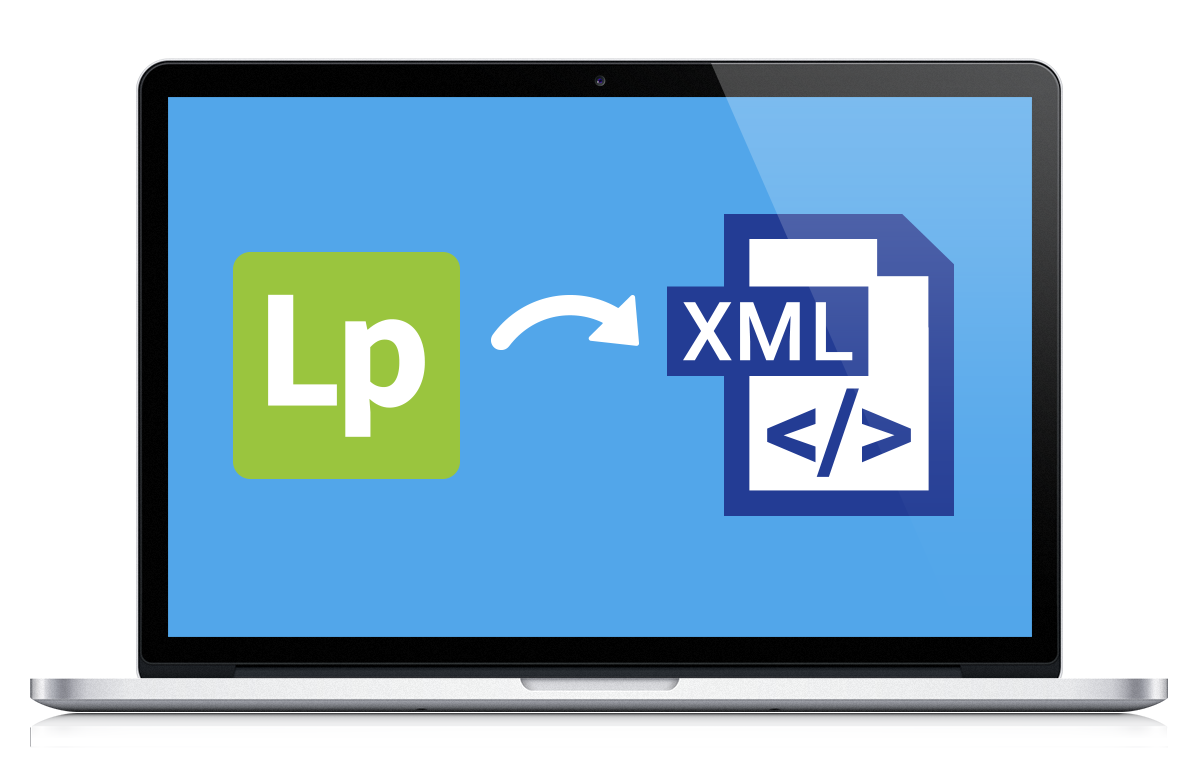
For example, data entry for EPA and CARB is consolidated in the GHG application, eliminating the need to maintain separate agency spreadsheets and software. This supports robust trend tracking and reporting, reducing data entry, reporting time, and error opportunities. For many greenhouse gas subparts, including Subparts C, D, W, and NN, the software automatically generates XML reports. These can be easily configured for any greenhouse gas industry segment.
From our experience, many of our customers have experienced frustration with the speed and difficulty of entering their data into the state and federal GHG reporting tools. The Locus Platform XML reporting tool lets customers bypass those clumsy interfaces completely. This saves time, helps companies avoid transcription errors, and ensures consistency with GHG data submitted to multiple reporting programs. As more and more regulatory and voluntary programs embrace automated report submittal through the XML format, Locus continues to expand this functionality to simplify reporting for our customers.
ESG reporting and EHS compliance are inherently cross-functional and coupled activities. Managing them together rather than separately is better. Locus built its platform on a highly secure, scalable, configurable, and efficient multi-tenant software platform. The traditional approaches to using a separate app or a spreadsheet for EHS compliance, sustainability management, or ESG reporting were ripe for digital transformation to a single platform of record. This is the main reason that we built the Locus Platform from scratch to take advantage of the latest cloud technologies and flexible and domain-driven reporting requirements.
Quality of data and standard protocols remain one of the biggest challenges to evaluating companies’ ESG performance. Such data are only credible if they come from the existing sources of EHS compliance data that are much more scrutinized and verified by regulators. Any potential conflict between two sets of the same data can spell disaster for the reporting entity. The perceived value of sustainable investments and practices is inevitably linked to data accuracy, consistency, and reproducibility.
The Locus Platform empowers companies to gain a holistic view of their sustainability performance by providing the means for them to assemble and report their EHS and ESG data from within a single system. Sustainability managers need comprehensive digital tools and real-time, AI-driven insights to keep up with the latest ESG disclosure requirements, trends, and stakeholder requests for information. Whether an organization is just getting started with sustainability initiatives or doing it for a while, Locus Technologies combined EHS and ESG software, explicitly tailored for multi-jurisdictional and multi-media reporting, can help companies make better and faster decisions and reduce the reporting cycle time. By quickly transforming corporate EHS compliance to ESG reporting, companies can improve their ESG score while lowering operational risks and costs. Locus software breaks down silos and provides a stable platform to work collaboratively with diverse teams of experts across the customer organization, its consultants, and its suppliers.
The biggest differentiator between Locus and other EHS software providers is our support team. Not only do we pride ourselves on the quickest and most efficient resolutions in the industry, but on our human approach to support. Get to know our support team as we recently sat down (virtually) with them to talk about the ins and outs of their field, how it is working for Locus, and more.
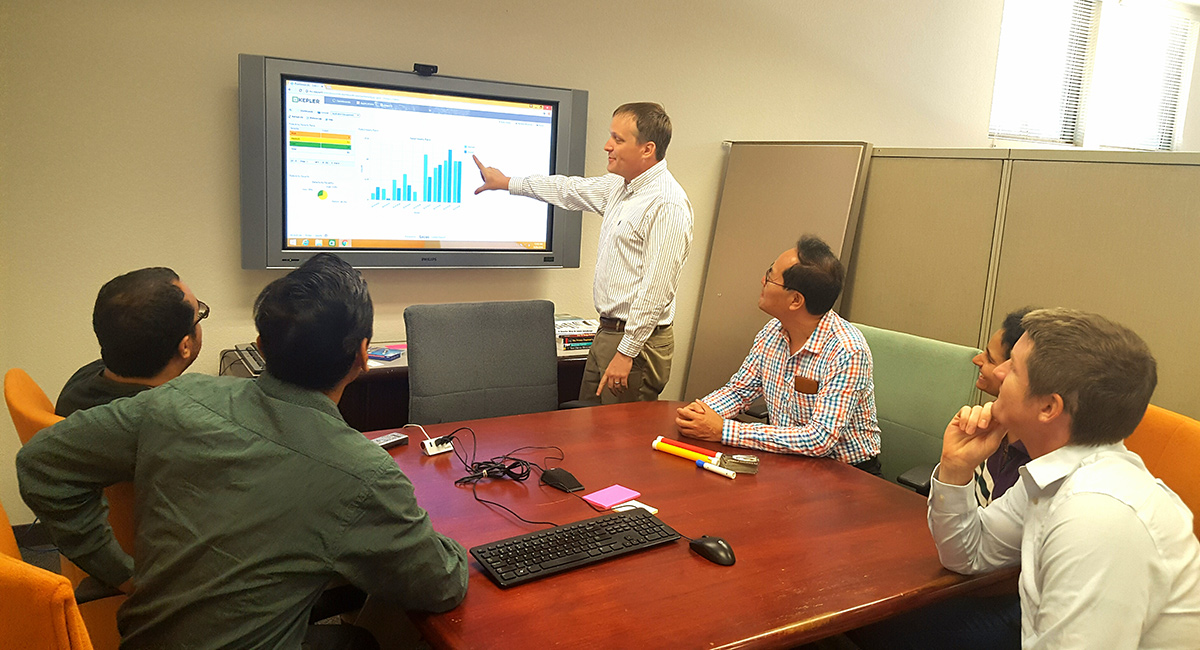
Our most common support case is user management related. Many times, our customers need assistance adding new users or updating their user lists. We receive a lot of requests for resetting passwords.
Almost ten years ago, there was a bug within SQL itself! It was quite a mystery. We would venture to say that we have at least one unique case every week. No single case is the same! It certainly keeps us on our toes. We also had a case once where an organization was acquired by another organization. Due to this, we had to rename the users and organizations which ended up resulting in over 300 user changes which impacted historic records.
It is our policy to respond to all cases within two hours of receiving them (given that they come in between the hours of 5am and 3pm Pacific Time). If they come in outside of those hours, we respond within 2 hours of beginning our normal hours. We get many compliments on how speedy our response times are! It is the policy of the team for Tier 1 staff members to check new cases every thirty minutes or so. Critical issues typically receive almost immediate responses! Quick response times are one of our proudest achievements.
We have had many cases where we have received numerous thank yous from the customer. There has been a time or two when a customer did a widespread data update without meaning to. Our quick response and ability to revert their changes was much appreciated. We have also been known to help our customers with some very interesting issues that require quite a bit of troubleshooting on our end. The Support Team is incredibly patient and willing to dive deep into questions that customer’s come to us with.
The Locus Support Team consists of many individuals from a variety of backgrounds ranging from Environmental Engineering, Biology, Environmental Science, Environmental Health and Safety, Mathematics, Data Management, GIS, and much more! The Tier 1 team consists of three outstanding individuals who work across the Support Team, Engineering Team, and Configuration team. The Tier 2 team consists of a wide variety of developers, configurators, and specialists in the field. Together, the Locus Support team has over 75 years of combined experience in the Environmental field. We have a few folks on the team that have outward appearances outside of the norm ranging from long hair, piercings, tattoos, and even purple hair.
Because our team is spread across the United States, with team members working out of the Asheville and Mountain View offices, as well as remote employees, we haven’t been impacted as much by the stay at home COVID-19 orders. Our team has always excelled at communication through email and other online chat services. The ability to talk through tools such as Teams and Skype, has given us the advantage edge during this pandemic. In addition, a large number of our Support Team are remote employees ranging across California, Tennessee, Indiana, Utah, and many other states.
The first answer that came to the team was that we are all a family! We are incredibly supportive and encouraging of one another and we have FUN while working! One of the fun things that we all have in common is our deep–rooted love for animals. One of our favorite pastimes is sharing pictures of our animals, as well as their silly antics! We also like to share about our parenting concerns, particularly during COVID-19 times! Locus is an amazing place to work, in part because of the educated, experienced and awesome personalities we have working as a WHOLE team, rather than just a support team. When asked, the number one response was the friendly and family-like atmosphere.
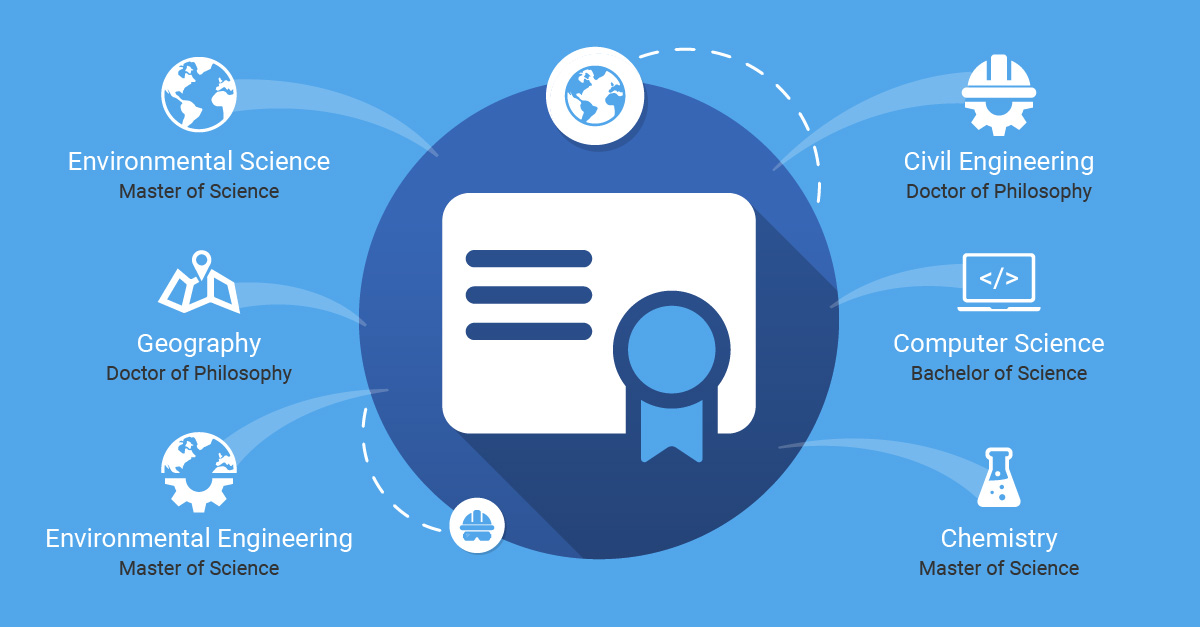
Master of Applied Science
Associate’s
Bachelor of Science
Certifications
For over 20 years, Locus environmental software customers have saved enormously on their setup and and data entry costs. This infographic highlights the aggregate savings of all users based on conservative estimates of time and cost for different aspects related to our software.
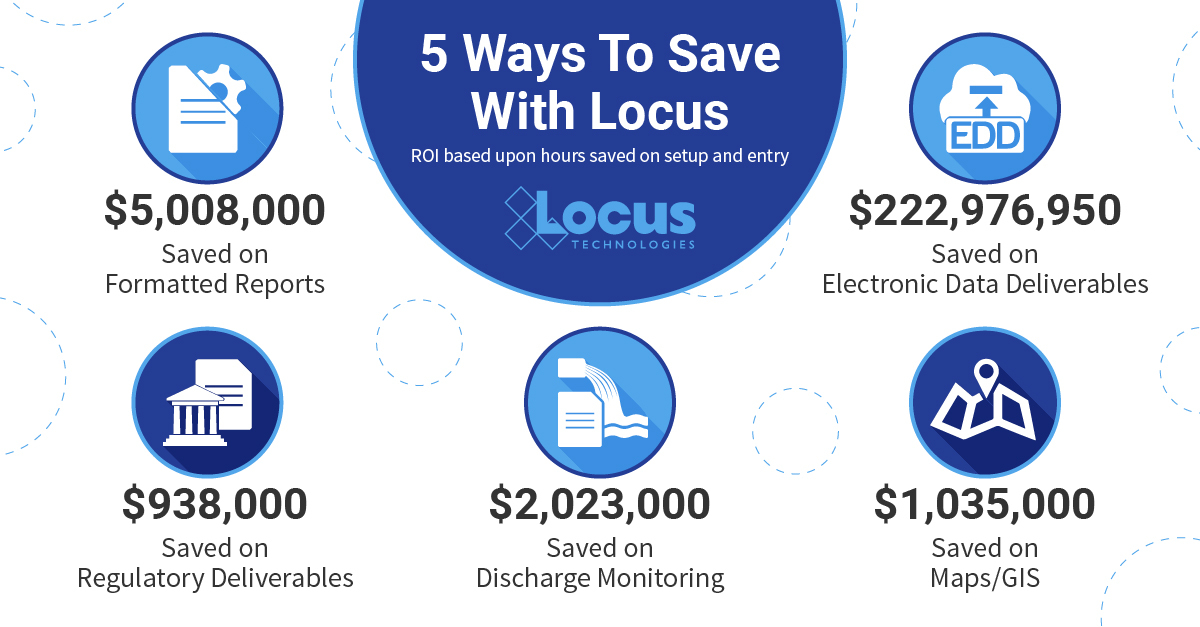
The global economy is currently being tested on a magnitude that we have never witnessed before. The effects of COVID-19 have pushed the limits of individuals, and the organizations that they run. As we collectively face short-term problems related to the pandemic, long-term effects of climate change have, in some ways, been magnified. When the dust settles, and we tackle COVID-19, we will still be facing the consequences of climate change. It is now, however, not after COVID-19 is controlled, that organizations must make steps towards tackling environmental issues. On a positive note, there is a return on investment in sustainability, and there are pragmatic ways of achieving sustainable goals.

The connection between saving money and resources and investing in sustainability is well known. Year after year, sustainable projects result in billions of dollars in savings for the companies investing in them. By 2030, return on investment in sustainability will be $26 trillion. And while those companies investing in sustainability have better numbers, they’re continuing to push for higher sustainability goals, as are government agencies. Companies not making these investments are not only missing out financially, but they are falling behind when it comes to long-term preparedness. Without a doubt, the organizations who are acting first have the leg up. When it comes to sustainability, two proverbs attributed to Benjamin Franklin are as true as when he first said them. “An ounce of prevention is worth a pound of cure”, and “a penny saved is a penny earned.” Pair those variables with the ever-growing awareness and importance of sustainability by the green investor and the green consumer and you have a powerful combination.
Nearly 80,000 emission-reducing projects by 190 Fortune 500 companies reporting data showed nearly $3.7 billion in savings in 2016 alone. – WWF | worldwildlife.org
With climate-related issues comprising the top five long-term risks in terms of likelihood, the need for investing in sustainability becomes all the more apparent. This sentiment is mirrored in a recent Bloomberg article, where Bill Gates suggests that the most difficult long-term problem facing the world today is climate change, and the effect it has on the environment. While outlining several difficulties, he points to one shining light in the fight to sustain a healthy climate: the acceleration and innovation of technology over the past two decades created to tackle the problem. Not many understand more than Locus the fight to maintain, and reduce, and use resources wisely. Locus has, for over two decades, provided advanced tools to improve sustainability on a grand scale.

Several organizations have taken advantage of the sustainability software solutions Locus provides. One example is Del Monte Foods, one of the largest producers of food in the world. They partnered with Locus for sustainability data management, eliminating errors in old data and better monitoring resource usage and cost. They also use Locus’ sustainability app to visualize and report data on the fly. They are tackling sustainability from a practical standpoint, addressing real data, not a nebulous idea. And they have been better off for acting early instead of waiting.

In the end, we must address the problems that face us. We need to tackle COVID-19 and how it affects our organizations, but be mindful that every quarter and every year that sustainability goals are pushed back, there are dollars being lost seeking out attainable improvements to our environment. Not only that, but every step that isn’t taken towards sustainable goals is a step behind other organizations making practical investments in their future and the wellbeing of everyone.
299 Fairchild Drive
Mountain View, CA 94043
P: +1 (650) 960-1640
F: +1 (415) 360-5889
Locus Technologies provides cloud-based environmental software and mobile solutions for EHS, sustainability management, GHG reporting, water quality management, risk management, and analytical, geologic, and ecologic environmental data management.
